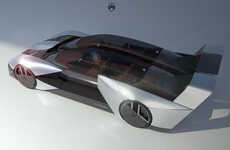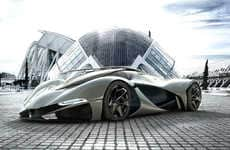
The Laminar 3 Concept Car Conforms to Changing Driving Conditions
Amelia Roblin — March 22, 2013 — Autos
References: dfitzgerald.au & tuvie
While many motorists stick almost exclusively to the same commute each day, a number of drivers would appreciate the value in a vehicle that can adapt to different environments. The Laminar 3 concept is an extension of Daniel Fitzgerald's Laminar 2 design, this time integrating a transforming back end that interacts efficiently with the wind.
The sharp rear end of the automobile can shift outwards and upwards to catch and guide the passing air in a way that will improve the speed and stability of the cutting-edge conveyance. It can readjust for meandering roads, long stretches of freeway and steady suburban driving. The low drag profile alters its angle easily so that it's smooth sailing in the Laminar 3 with its seductive transparent cabin and its tapering aerodynamic tail.
The sharp rear end of the automobile can shift outwards and upwards to catch and guide the passing air in a way that will improve the speed and stability of the cutting-edge conveyance. It can readjust for meandering roads, long stretches of freeway and steady suburban driving. The low drag profile alters its angle easily so that it's smooth sailing in the Laminar 3 with its seductive transparent cabin and its tapering aerodynamic tail.
Trend Themes
1. Transforming Vehicles - The concept of vehicles that can adapt to different environments opens up opportunities for innovative designs and improved functionality.
2. Aerodynamic Innovation - Developing vehicles with advanced aerodynamic features such as a transforming back end can greatly enhance speed and stability.
3. Sustainable Transport - Designing vehicles that optimize wind resistance can contribute to reducing fuel consumption and creating more eco-friendly transportation options.
Industry Implications
1. Automotive - Automakers have the potential to disrupt the industry by creating vehicles with transforming features that offer improved performance and efficiency.
2. Transportation - Innovations in aerodynamic design can revolutionize the transportation industry by providing more sustainable and energy-efficient options.
3. Design - Designers have the opportunity to create visually appealing and functional vehicles by integrating transforming features and advanced aerodynamics.
4.8
Score
Popularity
Activity
Freshness























